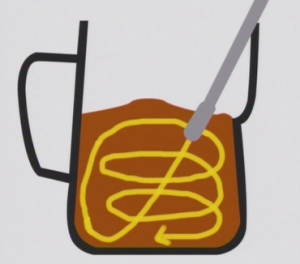Treatment of raw coffee beans after being plucked from trees: introduction to three treatment methods of raw coffee beans
Introduction to dry processing (Solar processing drymethod)
Drying method: with a soft sour taste and a peaceful bitter taste. This method is used in Brazil, Ethiopia and Yemen. Disadvantages: vulnerable to weather, defective beans and foreign bodies are more likely to mix.
Process: coffee is either dried naturally on the patio, or dried by machine, or both. The treatment is to spread the coffee cherries widely on the exposure field for two weeks and sweep them with a rake several times a day so that the coffee beans can be dried more evenly. When dried, the coffee beans are separated from the skin, and the dried pulp and peel are removed by a sheller, then screened and divided into different grades. Both washing and drying can produce the best quality coffee. Generally speaking, water-washed coffee has distinct acidity and consistent flavor, while dry coffee has lower acidity and more changeable flavor. Colombia, Kenya, Costa Rica, Guatemala, Mexico, and Hawaii all use water washing methods. Most of the coffee produced in countries including Brazil, Ethiopia and Indonesia is dried. The selection and grading of coffee depends on the particle size and concentration of beans, as well as how many defective beans are in a pound of beans. Like the best wine, the careful handling and selection of professional coffee in the production process can be seen in the quality of the beans, because the product will have a unique representation, which represents the origin, climate and growers. The water content of each fruit will drop to about 12%, when the fruit is dry. In Brazil, coffee beans at this stage are given a confusing name: coco. At this time, its skin turns dark brown and fragile, and coffee beans can be heard cackling in the shell. The process requires more technology than it seems. Because coffee beans can be overdried, if this happens, they can easily be damaged at the next stage, when they are shelled. On the other hand, coffee beans that are not sufficiently dried are also vulnerable.

Introduction of washing method (Wet processing wetmethod)
Washing method: good gloss, less foreign body mixed, slightly better sour taste, Colombia, Mexico, Guatemala use this method. Disadvantages: poor handling of time will produce bad smell and special sour smell.
Processing: picked coffee cherries, including freshly ripe, overripe, and unripe, are all mixed together. If these coffee cherries are not treated separately, the quality of the coffee beans is really unpalatable, because it is mixed with a lot of bad-tasting impurities. So these coffee cherries should be washed and placed in a large trough full of water for preliminary classification. The best coffee has a high density, so it sinks into the water. On the other hand, overripe coffee cherries will surface and can be easily classified. Remove the pulp from the outer layer of the coffee cherry and then soak it in a large sink filled with water. After fermentation, the water-washed coffee will have a distinctive and clear flavor. The fermented coffee beans are washed with clean water, then removed from the water and dried in the sun or machine. Finally, the peel and silver peel are removed by a sheller, which can be screened and divided into different grades of raw coffee beans.
Introduction to honey processing (semi-dry processing)
Processing: first remove the skin with water, and then go to the sun. This is a relatively new and rare method. This method is only suitable for specific areas of some countries, with a long drying period. The coffee produced by this method is sticky, and the mucus is not removed as it is fermented in the tank. Therefore, the coffee produced by this semi-washing method contains the characteristics of both washing and drying. The acidity, sweetness, seasoning, and flavor of the coffee are quite good; the disadvantage is that the coffee taste is not as strong as that produced by pure drying or washing.
Source:
Training Network for fresh graduates
Important Notice :
前街咖啡 FrontStreet Coffee has moved to new addredd:
FrontStreet Coffee Address: 315,Donghua East Road,GuangZhou
Tel:020 38364473
- Prev

Crema Analysis of Oil from Italian Coffee extracted and concentrated Espresso and observation of Color change
Crema (grease) I don't understand why we make Crema so much more complicated than itself. Crema is often seriously misdescribed, the most common of which is an emulsified oil. Well, I think it's fair to say that to a very small extent. As far as we know, the amount of oil obtained by Espresso in the extraction process is unique. In the process of Espresso extraction, the content of steam
- Next

Teach you the skills and tips of making a good cup of milk foam how to make a good cup of espresso?
Milk foam is a prerequisite for the success of a cup of espresso. Only when the foam is ready can you make a qualified cup of espresso. How can you make a good cup of Italian coffee? Let's explain in detail: how many points should we pay attention to before foaming! (1) Milk temperature: milk temperature is a very important factor in dispelling milk. when the storage temperature of milk increases by 2 degrees Celsius, it will be reduced by 1.
Related
- What is the meaning of lactic acid fermentation with coffee bean treatment?
- How to judge the state of foam by sound?
- How does the latte pull out the unicorn pattern? Come to get for a little trick to improve the flower pull!
- Will flower pulling affect the taste of the latte?
- Do you know the history of coffee?
- The difference between honey treatment and sun washing what is raisin honey treatment?
- What kind of milk can a novice use to make coffee foam to keep the foam longer? The correct method and skills of milking tutorial sharing
- Why do washed coffee beans taste sour? Flavor characteristics of washed Coffee
- Introduction to the skill of how to practice the size and height of water injection around the circle of hand-brewed coffee
- How do beginners practice coffee flower drawing from scratch?

